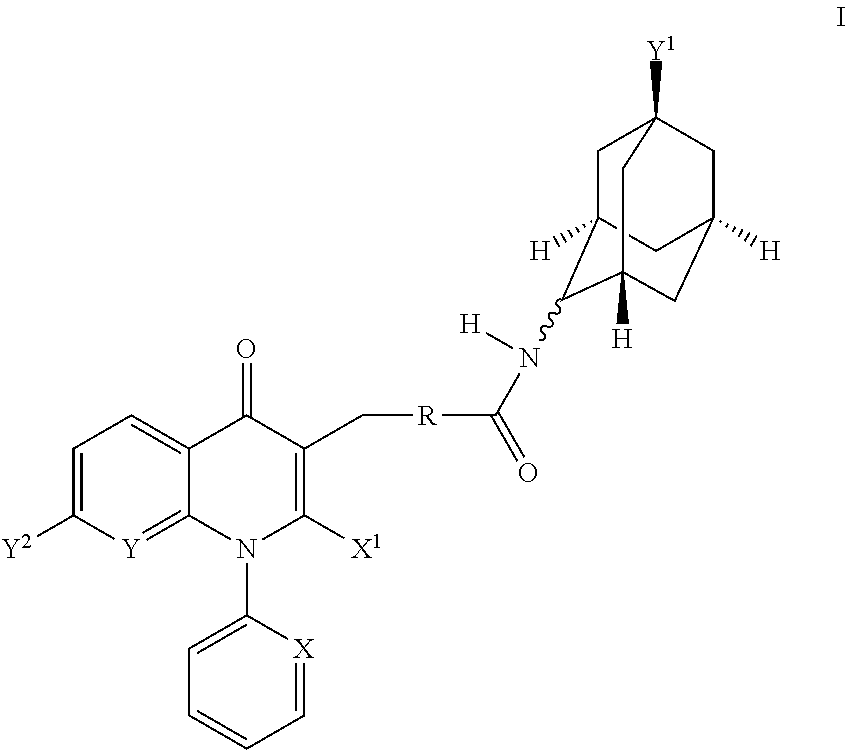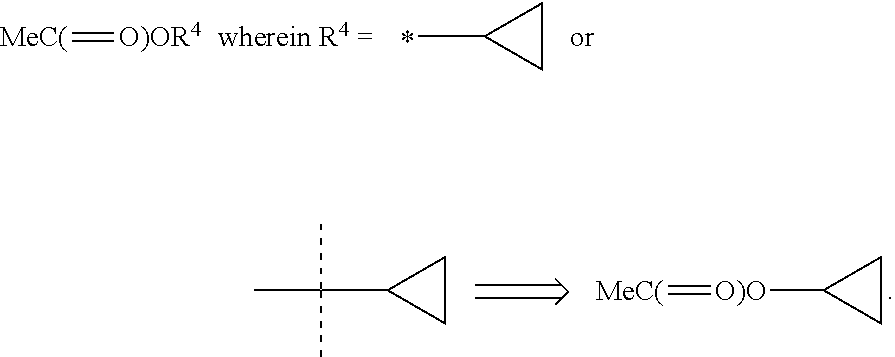Adamantyl compounds
a technology of adamantyl compounds and compounds, applied in the field of adamantyl compounds, can solve the problems of malignant tumor formation, debilitating joint damage and deformation of most ra patients, and end up with debilitating joint damage and deformation
- Summary
- Abstract
- Description
- Claims
- Application Information
AI Technical Summary
Benefits of technology
Problems solved by technology
Method used
Image
Examples
example 1
rel-3-[4-((1S,2S,3R,5S,7S)-5-Hydroxy-adamantan-2-ylcarbamoyl)-benzyl]-4-oxo-1-phenyl-1,4-dihydro-[1,8]naphthyridine-2-carboxylic acid methyl ester
[0275]
[0276]A solution of 3-(4-carboxy-benzyl)-4-oxo-1-phenyl-1,4-dihydro-[1,8]naphthyridine-2-carboxylic acid methyl ester (6.44 g, 15.5 mmol) in methylene chloride (150 mL, 0.1M) was treated with N,N-diisopropylethylamine (20.0 g, 27 mL, 153 mmol), (1S,3R,4S,5S,7S)-4-amino-adamantan-1-ol hydrochloride (see WO2007 / 107470 A2, 3.33 g, 16.3 mmol), 1-[3-dimethylaminopropyl]-3-ethylcarbodiimide hydrochloride (4.91 g, 25.4 mmol), and 1-hydroxybenzotriazole (3.41 g, 24.7 mmol). The reaction was stirred at 25° C. for 2 d. At this time, the reaction was diluted with methylene chloride (200 mL) and was washed with a 1N aqueous hydrochloric acid solution (2×200 mL), a saturated aqueous sodium bicarbonate solution (2×200 mL), and water (200 mL). The organics were dried over magnesium sulfate, filtered and rinsed with methylene chloride and concentrat...
example 2
rel-3-[4-((1S,2R,3R,5S,7S)-5-Hydroxy-adamantan-2-ylcarbamoyl)-benzyl]-4-oxo-1-phenyl-1,4-dihydro-[1,8]naphthyridine-2-carboxylic acid methyl ester
[0277]
[0278]A solution of 3-(4-carboxy-benzyl)-4-oxo-1-phenyl-1,4-dihydro-[1,8]naphthyridine-2-carboxylic acid methyl ester (0.18 g, 0.43 mmol) in N,N-dimethylformamide (2.2 mL, 0.2M) was treated with N,N-diisopropylethylamine (225 μL, 1.29 mmol), 4-amino-adamantan-1-ol hydrochloride (mixture of cis and trans isomers) (83.5 g, 0.45 mmol) and benzotriazole-1-yl-oxy-tris-(dimethylamino)-phosphonium hexafluorophosphate (0.29 g, 0.65 mmol). The reaction was stirred at 25° C. overnight. At this time, the reaction was washed with a saturated aqueous ammonium chloride solution and a saturated aqueous sodium bicarbonate solution. The organics were dried over sodium sulfate, filtered and concentrated in vacuo. Flash chromatography (40 g silica gel column, 0.5-4% methanol / methylene chloride) gave two sets of product fractions. Each set of fractions ...
example 3
rel-7-Chloro-3-[4-((1S,2S,3R,5S,7S)-5-hydroxy-adamantan-2-ylcarbamoyl)-benzyl]-4-oxo-1-phenyl-1,4-dihydro-quinoline-2-carboxylic acid methyl ester
[0279]
[0280]A solution of 3-(4-carboxy-benzyl)-7-chloro-4-oxo-1-phenyl-1,4-dihydro-quinoline-2-carboxylic acid methyl ester (100 mg, 223 μmol) in methylene chloride (10 mL) was treated with N,N-diisopropylethylamine (291 mg, 2.25 mmol), (1S,3R,5S,7S)-4-amino-adamantan-1-ol hydrochloride (see WO2007 / 107470 A2, 71.8 mg, 335 μmol), 1-[3-dimethylaminopropyl]-3-ethylcarbodiimide hydrochloride (69.2 mg, 357 μmol), and 1-hydroxybenzotriazole (55.8 mg, 357 μmol). The reaction was stirred at 25° C. for 18 h. At this time, the reaction was diluted with methylene chloride and was washed with a 1N aqueous hydrochloric acid solution, a 1M aqueous potassium carbonate solution, water and a saturated aqueous sodium chloride solution. The organics were dried over magnesium sulfate, filtered and concentrated in vacuo. The residue was diluted with a small am...
PUM
| Property | Measurement | Unit |
|---|---|---|
| current amplitude | aaaaa | aaaaa |
| particle size | aaaaa | aaaaa |
| temperature | aaaaa | aaaaa |
Abstract
Description
Claims
Application Information
 Login to View More
Login to View More - R&D
- Intellectual Property
- Life Sciences
- Materials
- Tech Scout
- Unparalleled Data Quality
- Higher Quality Content
- 60% Fewer Hallucinations
Browse by: Latest US Patents, China's latest patents, Technical Efficacy Thesaurus, Application Domain, Technology Topic, Popular Technical Reports.
© 2025 PatSnap. All rights reserved.Legal|Privacy policy|Modern Slavery Act Transparency Statement|Sitemap|About US| Contact US: help@patsnap.com



